#tunisian model
Explore tagged Tumblr posts
Text



ETHAN WINTERS resident evil village, 2021
#ethan winters#resident evil village#resident evil#re8#re village#residenteviledit#reviledit#gamingedit#* mine.#i wish the model viewer would animate his face but alas you have to mod it just to see his face#also! did yall know ethans model is tunisian? now you do :)
197 notes
·
View notes
Note
what are your biggest asoiaf fancasting pet peeves, especially in regards to more popular fancasts in the fandom?
a lot of people will just throw any old blond in there and call it a targaryen without thinking about the vibes. like charlize theron for rhaella gets used a lot and it's like bro.....that is NAWT charlize lmao have you SEEN the sort of roles she plays even when she's more "damsel"-y she's got a grit and a fire to her that you simply can't hide and that is not even CLOSE to the way rhaella is described. or - and like, no shade, i get it, it's hard to find fancasts -but i'll see a veritable twink used as maegor and it's like hmmmmmmmmm.
then there's "casting" people who just can't act. again, i totally get it, who doesn't like to use henry cavill in their graphics he's just easy and it's not like the show didn't cast some pretty spectacularly bad actors (hello emilia kit and aiden) but um. he may be a nerd but he is NOT up to asoiaf snuff! people do that in particular for rhaenys, lyanna, and ashara, just casting some cw girlie who doesn't emote bc she's pretty. boring. next!!
and of course the age thing. i get its hard to match ages (god knows i struggle with sansa, and i'm AWARE asivak is way too old for jon snow) but people are out here casting like 30+ year olds for arya, lyanna, asha, arianne, and it's like guys. arya is barely starting puberty lmao i like millie brady too but she is twice lyanna's age. at least do the teen show thing where you cast young looking 20 year olds as teens!
also i do in general kinda shy away from big name bollywood actors as dornish characters, although that's not a hard and fast rule. i know it's a Whole Thing that like, oftentimes west asians and maghrebi people will get erased for south asian and usually specifically indian actors, and while i don't think it's like a Huge deal when we're talking about a fictional ethnicity, i DO think the overabundance of indian faceclaims when there are quite a few west asian and north african actors that work for the characters is a very weird and annoying trend.
#ESPECIALLY in recent years: re maghrebi and west asian actors there's been a slight shift in casting#there's actually quite a number of moroccan tunisian algerian palestinian syrian etc actors & models that have come up#in the last several years i mean hello look at sofia boutella and rami malek hiam abbass marwan kenzari#why are we STILL only using like aishwarya rai and alia bhatt and ranveer singh as like nymeria mors and elia#and i say this as a ranveer and aishwarya stan i forced my library to buy all of their movies bc we didn't even have fucking devdas#and our bollywood section was POPULAR. i bought every ranveer singh movie available in the usa for us!#but like. maybe we can use Khaled El Nabawy for Oberyn every once in a while ya kno!!!!#asks#psychicpiratementality
5 notes
·
View notes
Text


Ali Latif - Tunisian, Unknown
#face claims#face claims central#character inspiration#models#male models#male face claims#male model#male beauty#tunisian#tunisian male models#tunisian face claims#arab#arab fc#arab models#arab male#arab male models#northern african#north african#northern african male#north african models#rpg#rp oc#oc rp#fancast#fan cast#wattpad
1 note
·
View note
Text
Tunus işi örgü dikdörtgen şal yapımı✨️ Örgü modelleri
Bu videoda sizlere tunus işi dikdörtgen şal yapımını anlatıyorum. Sorularınız için yorum bırakın lütfen. Keyifli seyirler dilerim. Sevgiler benden 💕💕💕 Beğendiyseniz Beğen butonuna basmayı ve Yorum bırakmayı unutmayın Modeli yaparsanız instagram https://www.instagram.com/hayatm_orgu/ hesabımdan benimle de paylaşırsanız sevinirim. A Merhaba Hayatım Örgü diyenler ve örgü severler 🙂 Kanalımda bir çok…
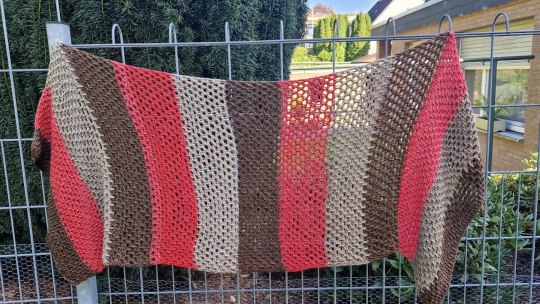
View On WordPress
#Çokkk güzel çok kolay tunus işi dikdörtgen şal yapımı Örgü modelleri#crochet#örgü dikdörtgen şal modelleri ve yapılışı#Örgü modelleri#örgü şal modelleri#şal örgüsü yapımı#tunisian crochet shawl pattern free#tunus işi hırka modeller#tunus işi kolay örnek yapımı#tunus işi örgü modelleri#Tunus işi patik modelleri#tunus işi şal örnekleri#tunus işi yelek modelleri
0 notes
Text
Fire Emblem Three Houses Crochet Wyvern - attempt 1
I finally finished it! It's taken me since the end of March 2022 (on and off, I got sidetracked making Alligator Loki for a while) but my prototype wyvern is done


Wyvern is 123.5 inches / 10foot 3.5 inches / 313.69cm wingtip to wingtip, and 56 inches / 4 foot 6 inches / 142.24cm nose to tail tip, and roughly 6 lbs / 2.72 kg ish. So a chunky baby He was made out of aran weight yarn using a 5mm hook and for the most part is Tunisian knit stitch. His toes were done in Tunisian simple stitch, and I think I did his teeth in normal rounds?
And now I do a cut to save everyone's feeds from all the pictures I'm going to share ^_^
(For reference, here are two photos of the wyvern from in game)
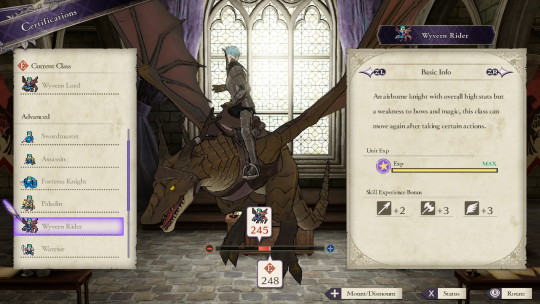

First, a few more angles on wyvern, and then I'll point out things I want to change for the next one



He's a handsome lad, and very recognisable for what he's meant to be!
But he also could be improved. A lot
Example 1, I lined up wyverns nose and tail tip against the in game 3d model to see how close he was to being accurate. And, er. yeah.
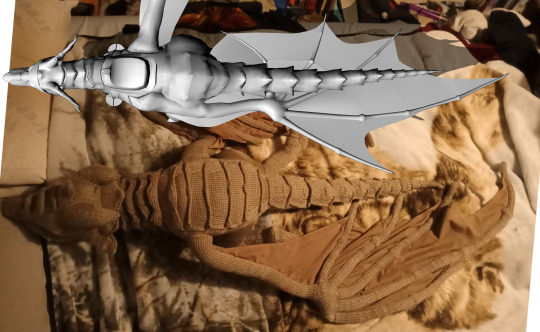
To give myself credit, when I first started this back in March 2022, I was working out lengths and widths and general sizing from screenshots taken from examining units in Three Houses, where I traced the outline onto a sheet of paper to measure things and perspective makes things AWKWARD, ok? (As is having brain farts and not remembering that the ruler had metric on the other side of it, but shush, let's not mention that bit)
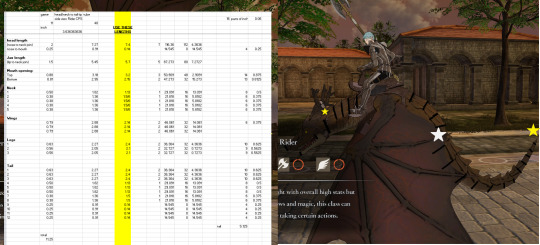
So the biggest thing to fix will be the scaling, if I can. I can definitely make the tail longer, the head shorter and thinner, the chest between the wings thinner, the wing sockets bulkier, and thanking all the stars, the wings get to be smaller too. By a LOT
The other major thing I want to do different/better is how the ridges along his back from nose to tail tip work.

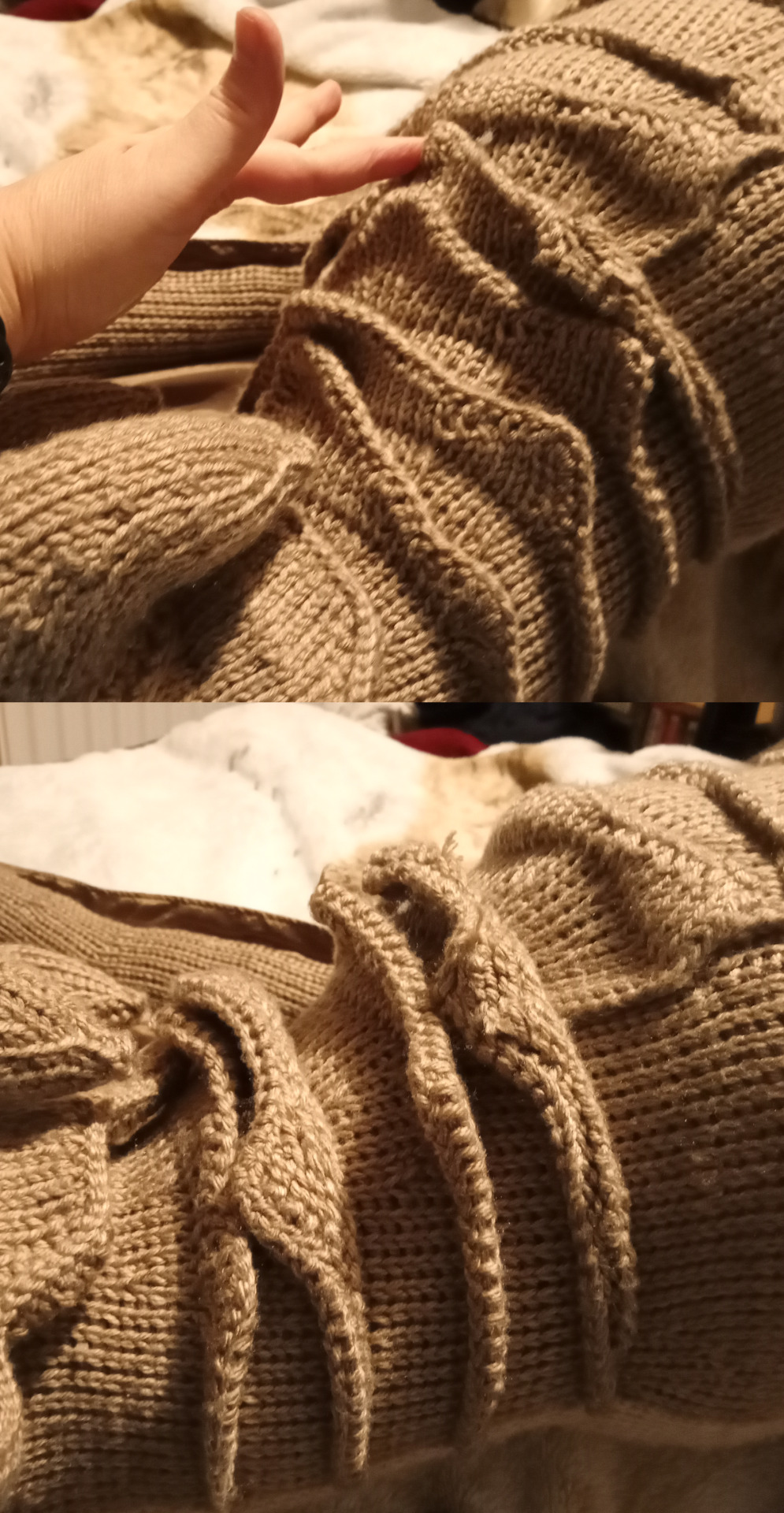
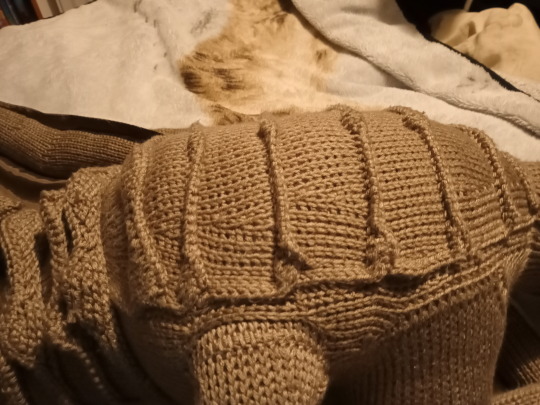

While they do work on wyvern, they don't look as great as I think they potentially can? So I'm going to be doing double layers of crochet, sort of, to help give the sticky up bit of the overlapping ridges more definition, and hopefully make them look like the slightly thicker scaling they're meant to be. It'll also help to smooth them out, so they won't have the weird dips where I've joined one to the next
I'm going to do the wings differently too, because what I did with these ones was quite frankly awful? I cut each wing segment into individual pieces to then hem and flip inside out to over sew the visible edges, and then hemmed up the sides that went inside the struts to then sew the crocheted parts to the fabric. So the fabric was the cheese to the crochet bread in this awful, awful sandwich situation. I am also never, ever buying anything that is even vaguely silky or satiny or slippery ever again for anything
For the next one I'll keep the two pieces of wing fabric as one big piece, since the top and bottom of the wing membranes are actually slightly different colours if you look closely, but I'm going to cheat and use some of that iron on hemming tape stuff to fill the inside of the fabric after I've done all the outer hemming and over sewing so it'll kind of look like all the veins and stuff that the membranes have? So the fabric hopefully won't slip around so much, so will be easier to sew, and keeping it as one big piece means there's less change of me messing up the positioning of the struts on the panels because the wings on this one aren't equal despite my best efforts
Next is Claude's white wyvern, but it'll be made with DK yarn and either a 3.5 or 4mm hook, so it will (hopefully) come out significantly smaller than this one. And that one is going to get plastic boning/skeleton in it, so it'll be poseable!!!
60 notes
·
View notes
Text

Luka Spaziani-Booth (UK, - )
Tunisian model Myriem Boukadida (1997) for Vogue Arabia, November 2022. Campaign for Maitrepierre SS22 [b/w edit w bulky Prada earrings removed]
s: https://lukabooth.com/portfolio
#Myriem Boukadida#model#beauty#nose#photography#Luka Booth#Luka Spaziani-Booth#portrait#fashion#hi resolution
81 notes
·
View notes
Photo




A poetic touch in Rajwa Al Saif’s henna celebration look.
Embroidered in gold, the Arabic verse translates to read: “When I see you, life becomes more beautiful” — adding a personal touch to Rajwa Al Saif's henna celebration gown designed by Saudi brand Honayda Serafi.
The poem comes from Tunisian poet Al Qasim Al Shabbi, who is known as the "poet of life" for generations of Tunisians who were taught to recite his verses from a very young age.
“I was actually searching with my team to find something that can deliver and explain this eternal love between her and Prince Hussein,” Serafi tells The National. “They are role models and they are setting a new love story for everyone to look up to; they are inspiring the young generation to have this kind of honest and pure and strong love between them.”
Born in 1909, Al Shabbi was known for his desire to create change and revolutionise minds through his poetry. He wrote about the future, art, his homeland, nature and the desire to fully immerse in the pleasure of living.
He believed in change and rebirth, and for that reason, he was nicknamed “the poet of life”. Despite suffering from a heart disease, which eventually led to his death at the young age of 25 in 1934, Al Shabbi made sure to remind young people that the desire to live must conquer all momentary whims.
He chose life in most of his poems, and most importantly, chose the love for his country as the highest form of love — a passion he passed on to future generations of Arabic poetry readers. Similar to all his poems, the Arabic lettering verses that are seen on Jordan’s future royal bride are another illustration of the divine love he sought to spread. (x)
50 notes
·
View notes
Note
do you have any alts for golshifteh farahani

honestly, i don't have a good one. here's list of some other arab ladies who i think could make a good replacement, but realistically most of them don't have many resources, if any at all. let me know if you'd like a more broad set of fcs in terms of specifics vs vibe! i think that sentence makes sense lol
Annie Parisse ( 1975, actress, one quarter Lebanese )
Eve Harlow ( 1989, actress, parts Mongolian && unspecified Middle Eastern/Jewish )
Hanaa Ben Abdesslem ( 1990, model, Tunisian )
Leïla Bekhti ( 1984, actress, Algerian )
Moran Atias ( 1981, actress, Moroccan/Jewish )
Nadine Labaki ( 1974, actress, Lebanese )
Nadine Nassib Njeim ( 1984, actress, half Lebanese && half Tunisian )
Rima Fakih ( 1985, model, Lebanese )
Sarah Kazemy ( 1987, actress, half Iranian && half Algerian )
Yasmine Al Massri ( 1978, actress, half Egyptian && half Palestinian )
Yasmine Hamdan ( 1976, musician, Lebanese )

#golshifteh farahani fc#middle eastern fc#arab fc#faceclaim suggestions#answered: alt fc#answered: fc help#answered: anonymous#answered#five nights at freddi's: mascot post
12 notes
·
View notes
Text

Tunisian Model Myriem Boukadida: “My Goal is to Always Represent the Arab World and the Region”
3 notes
·
View notes
Text
Among all Arab civil society organizations, the Nobel Prize-winning Tunisian General Labour Union (UGTT) has arguably done the most to defend the ideals of democracy in the region. It was a key guarantor of Tunisia’s transition to democracy after 2010 and continues to stand up to authoritarian President Kais Saied, refusing to support the sham parliamentary elections he orchestrated last December and January.
What is less well understood is that the UGTT has contributed to the fiscal and economic crisis that enabled Saied’s authoritarian rise. It has defended the interests of relatively privileged insiders on the labor market—public sector employees—while doing little or nothing for Tunisia’s vast army of unemployed and informally employed outsiders who work in the private sector without formal contracts or social security. This has contributed to economic inequality, social frustration, and pervasive economic inefficiency.
The situation is typical of a general economic ailment throughout the Arab world outside of the oil-rich Gulf: static systems by which the state protects shrinking groups of insiders while exposing outsiders to the brute forces of the market, thereby encouraging inequality and undermining economic dynamism, productivity, and growth. Countries as diverse as Algeria, Egypt, Jordan, and Morocco share this lopsided approach to capitalism.
In all these cases, the state protects insiders not only on the labor market but also among businesses, which are broadly divided into crony firms with deep connections to the state on one hand and marginal, informal firms on the other. The latter receive little state support and, if anything, try to avoid the government’s heavy bureaucracy.
As I argue elsewhere, the Arab world’s economic development issue is not simply one of “too much state,” as many pro-market reformers argue, or state withdrawal, as leftist critics advocate, but instead of the state’s very uneven presence: overprotecting some while neglecting and marginalizing others. This uneven system is ensconced through vested interests that form key political constituencies: namely, state employees and crony networks in business.
Outsiders, by contrast, are much less well recognized as political constituency as they are socially marginal, busy with daily survival and badly organized. The static nature of Arab economies gives few incentives to firms or workers—whether insiders or outsiders—to upgrade productivity or skills, leading to stagnant economies.
To reach a more inclusive social contract and a new growth model, the region needs a form of egalitarian liberalization: a transformation of insider privileges into general social safety and support mechanisms that might be less generous but are more broadly available, safeguarding social inclusion as well as fair competition and economic dynamism.
For the time being, such fundamental change is not in sight. The region’s insider-outsider divides have deep historical roots in the ambitious, state-driven economic development programs of the post-World War II era. Especially in populist republics such as Algeria, Egypt, and Syria, these programs involved control over the private sector as well as larger state apparatuses and more extensive state employment than in any other region of the global south, a legacy that is difficult to change.
Public sector workers are a core historical constituency of Arab regimes and their relative privileges have survived successive rounds of austerity and partial liberalization surprisingly well. Across the region, government payrolls maintain a state-dependent middle class. The shares of public workers in both the total workforce and among workers with a formal contract are far above the levels in other developing regions, the result of historical promises—sometimes enshrined in law—to offer state jobs to all graduates.
Most insider jobs in government allow at best a modest lifestyle, and in some cases public sector workers have experienced substantial declines in real incomes. Yet hourly wages remain higher than in the private sector (including private employees with formal contracts), which is unusual in comparison to other regions. In Latin America, for example, a more fluid labor market means there is no systematic public sector wage premium. Job security in the Arab public sector is very high and welfare benefits, especially pensions, are much better than in the private sector.
Politically driven insider employment can impose large efficiency costs in the public sector. Overemployment is particularly rampant in state-owned enterprises: In 2021, Tunisair owned 26 aircraft, of which only seven were operational, while employing 7,600 people—more than 1,000 per functioning plane. The UGTT has resisted all attempts to consolidate the payroll.
Maintaining such insider constituencies is expensive. Tunisia has one of the world’s highest spending ratios for public salaries, reaching 15.1 percent of GDP in 2022. At the same time, fiscal constraints restrict new hiring, which means that young jobseekers have scant chances of getting a government job. Given weak job creation in the private sector, most young Arabs are either unemployed or stuck in precarious and badly paid informal jobs such as street vending or driving. Labor force surveys show unusually low mobility between insider and outsider status: The informally employed remain so for a very long time, while public sector insiders almost never leave their jobs.
High spending on insider benefits leaves few resources to support private labor market outsiders, who receive little or no social assistance. Spending on benefits not tied to formal employment is lower than in all other world regions. Non-contributory pensions, unemployment benefits, and cash grant systems are underdeveloped, leaving the weakest behind.
The frustration of outsiders has shaped Arab politics. In Tunisia in particular, outsiders have been prominent in social protests. Tunisian street vendor Mohamed Bouazizi, whose self-immolation triggered the Arab uprisings of 2010-11, was a quintessential outsider. Yet political feedback loops have kept the current system in place: Regimes are afraid of touching insider privileges given their long-standing reliance on the state-employed middle class as a core political constituency.
To the extent that political mobilization is possible, insiders are also better organized—most notably in Tunisia through the UGTT, but also in Egypt during its brief liberal window after the fall of then-President Hosni Mubarak in 2011, when newly emerging independent unions mostly represented state employees.
Even when military dictator Abdel Fattah al-Sisi took over Egypt in 2013, the one law his docile parliament refused to ratify contained civil service reform measures. Outsiders stage occasional demonstrations, but they seldom demand systemic changes to labor markets or welfare systems. They rather tend to ask for government jobs—demanding to be made insiders rather than overturning the system.
Meanwhile, thickets of protective regulation inherited from the post-war era of state-driven development facilitate corrupt networks between state and business elites. Licensing and inspection requirements, state-controlled access to land and credit, discretionary subsidies, and trade protection remain pervasive.
State elites use such tools to protect insiders while making it difficult for the vast army of unconnected firms to compete. Empirical research on Arab cronyism shows the staggering scale of insider privilege. In Egypt, “politically connected” companies under Mubarak accounted for only 11 percent of total employment but held 60 percent of total net profits among listed firms.
The 2010-11 uprisings were in no small measure directed at corrupt business barons, yet they have done little to remove crony networks. Egyptian steel tycoon Ahmed Ezz worked as a widely despised political fixer for Mubarak and was one of most high-profile arrests after Mubarak’s fall. Yet he has since left prison, and his companies, which benefit from cheap state-provided energy, are reporting bumper profits.
As in Arab labor markets, there is very low mobility among firms between insider and outsider status. Arab companies stay small and informal for longer than in other regions, while large firms go out of business less often than elsewhere. Even more than in the case of labor, insider companies are better organized and able to influence state decisions. When markets are formally liberalized, notably in the context of international trade agreements, insider firms often manage to lobby for new discriminatory rules in other areas of regulation to safeguard their privileges.
Sheltered insider firms have few incentives to become competitive, while outsiders have little opportunity to grow and innovate. The static insider-outsider divides in the Arab private sector contribute to low productivity, weak innovation, and poor export performance. One byproduct of this structural weakness is the scarcity of good, formal jobs in the private sector, which in turn reinforces the Arab middle classes’ reliance on and demand for state jobs.
Together with weak state education systems, this results in weak skill levels across Arab economies. This further reduces the chances of outsiders to find good jobs—and makes insiders cling to their privileges further, given their lack of competitiveness on a more open market.
In sum, the widespread narrative that neo-liberal, pro-market reforms have led to inequality, corruption, and economic stagnation across the Arab world is at best incomplete. While mismanaged and self-dealing liberalization measures have contributed to all these problems, the abiding, deep protection for select groups of insiders from the market is just as problematic and distortive.
Unless a new social contract is found, the inefficiency of the current system will make everyone worse off in the long run, including insiders the state can no longer afford to support. Egypt has travelled the furthest down this road towards general pauperization. Repeat rounds of currency devaluation have started to bring insiders in the public sector workforce down to the level of outsiders (while generally preserving the interests of crony businesses).
While Sisi’s regime has made attempts to create more inclusive social safety mechanisms, these have remained modest due to the regime’s fiscal constraints and its inability to address the major inefficiencies created by cronyism in the private sector.
What the region instead needs is an egalitarian liberalization, under which insiders give up some or all of their privileges while the state steps up its support for outsiders through more systematic investments in universal social security, entrepreneurship, and training.
Public sectors could be downsized through voluntary golden handshake policies, early pension packages, and assistance programs for finding private jobs—all coupled with state wage support for lower earners in the private sector to reduce wage inequality and combat poverty more effectively. Crony insiders in the private sector must be exposed to real competition, with state elites building a broader support base among the private sector at large.
Negotiating a new social contract along these lines will require political leadership and the willingness to recognize outsiders who tend not to mobilize against the state—by now a majority in all Arab countries—as a key political constituency. This is harder in the region’s authoritarian environment, with its limited or absent party competition and tight controls over civil society. By contrast, in Latin America, new welfare policies with a stronger focus on informal workers often emerged in the wake of democratization.
Short of a miraculous return to democracy in the Arab world, one can only hope that its authoritarian rulers understand how the current system gradually erodes their own support base: They are increasingly unable to maintain the old social contract with labor market insiders, a shrinking constituency.
It would be in rulers’ own long-term interests to start devoting more attention to outsiders who, while not organized as a lobby, are capable of spontaneous unrest that has critically contributed to past unrest and revolutions. Rulers would also do well to remember that citizens’ hatred of unproductive crony capitalist insiders was a key factor that brought people into the streets during the last wave of uprisings.
5 notes
·
View notes
Note
Hiya! Messaging to request some fc suggestions please? Needing help finding an fc for my character who will is very southern gothic, Ethel chain's Preacher's Daughter album, bones & all and southern blues inspired, I imagine her as dark haired and between ages of 25 to mid 30s - all ethnicities/races/genders come but if you don't mind me specifying , can I ask for only actors to be listed please? Aka no influences, singers or models etc - thank you so so much in advance!!!
Southern gothic, Ethel cain fc request here again sorry!! Forgot to add but if you don't mind me adding - also ideally someone who gives off messy/haphazard vibes please?? Kinda like they're obviously on the road a lot so have a permanent grease vibe?? So sorry if that's too specific and apologies again for adding this bug again tysm in advance!!!
Annabelle Wallis (1983) - Malignant.
Diane Guerrero (1986) Colombian - Doom Patrol.
Jodi Balfour (1987) - Quarry.
Courtney Bandeko (1988) Nigerian - Legacies.
Ritu Arya (1988) Indian - Lady Parts, Polite Society.
Nadia Hilker (1988) Tunisian / German - in The Walking Dead.
Nico Tortorella (1988) - is genderfluid, poly, pansexual and demisexual (any pronouns) - Fear The Walking Dead.
Rob Raco (1989) - Riverdale.
Hannah John-Kamen (1989) Nigerian / Norwegian - Resident Evil.
Michael Vlamis (1990) 37.5% Lebanese 25% Greek 25% Serbian 12.5% English - Roswell: New Mexico.
Emory Cohen (1990) - Lords of Chaos.
Kiowa Gordon (1990) Hualapai, English, Scottish, Danish, Manx - Blood Quantum.
Sarah Kameela Impey (1991) Indo-Guyanese / British - iWe Are Lady Parts.
Vico Ortiz (1991) Puerto Rican - non-binary (they/them) - Our Flag Means Death.
Joe Keery (1992) - Stanger Things.
Kiana Madeira (1992) Portuguese / Irish, Unspecified First Nations, Black Canadian - Fear Street.
Hari Nef (1992) Ashkenazi Jewish - is trans - Assassin Nation.
Katerina Tannenbaum (1993) - Betty,
Joseph Quinn (1993) - Stranger Things.
Taylor Russell (1994) Black Canadian / European - Bones and All.
Han Sohee (1994) Korean - My Name.
Lily Sullivan (1994) - Evil Dead Rise.
Sophia Ali (1995) Pakistani / Sicilian Italian, Danish, Norwegian, German - Uncharted, The Wilds.
Sasha Lane (1995) African-American, Māori, English, Scottish, Sorbian, French, Cornish, distant German, Italian, Belgian Flemish, Russian, and Northern Irish - is gay and has schizoaffective disorder - American Honey.
Adeline Rudolph (1995) Korean / German - Chilling Adventures of Sabrina.
Sarah Pidgeon (1996) - The Wilds.
Elliot Fletcher (1996) - is trans masc - Y: The Last Man.
Aria Shahghasemi (1996) Iranian - Legacies.
Archie Renaux (1997) English, Punjabi Indian.
Luka Sabbat (1997) Afro-Haitian, Irish, English, German.
Sydney Park (1997) African-American / Korean - There’s Someone Inside Your House.
Daisy Edgar-Jones (1998) - Where the Crawdads Sing.
Julia Dalavia (1998) Brazilian - Pantanal.
Felix Mallard (1998)
Hey anon! This ask was way harder than it should have been so I hope my followers give you more suggestions because I was struggling! Please keep in mind that some of these just give move around vibes.
4 notes
·
View notes
Text
iki şiş örgü model anlatımı✅️yelek süveter hırka modelleri✅️bebek örgüleri✅️crochet knitting✅️bridle
#saadetinelemekleri #stricken #babyzöpfe #بنائی #strickmuster #elörgüsü #handmade #easyknitting #вязаниеузоры #knittingpattern #kitting #knitting #knithindi #knit #knittingdesign #knittingpatterns #stich #modelos de tejer #colored #nice #vest #scarf #two #knittingneedles #baby #örgümodelleri #örgümodeli #orgumodelleri #easycrochet #easycraft #tunisian #patrones #crocheting #crochetbag #bunai…

View On WordPress
2 notes
·
View notes
Text
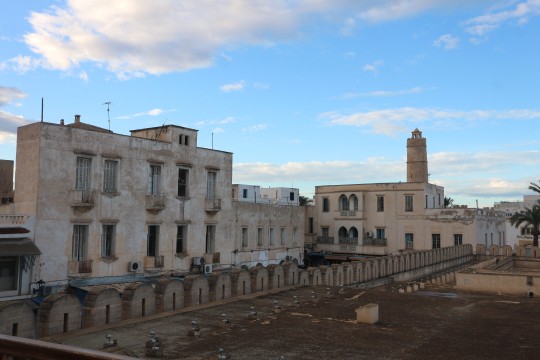








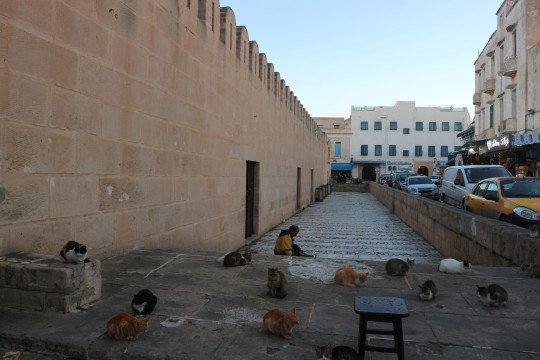
The Islamic city shows itself to be both a homogenous whole and a juxtaposition of sub-units; each neighbourhood is, in some way, a miniature city, complete with everything a city contains.
Jamila Binous.
The latest in my Tunisia series; please see here, here, here, here, here and here for the rest.
Tunisia, which was always home to the Berber people (who make up much of Tunisian DNA but whose language and culture have sadly declined), has also been the home and/or battleground of dozens of other ethnic/religious groups, as below.
What is now Sousse was formerly the Roman city of Hadrametum, built on a site where the Phoenicians and Carthaginians, sea-borne colonists from the Near East, had earlier based themselves.
The Roman Empire also lasted centuries, sprawling as far as what is now my home country of Britain, but it collapsed in the fifth century AD and in 434, Hadrumetum was sacked by the Vandals, who founded a Germanic kingdom in Africa (and whose name has been immortalised as a word for mindless violence, although the historic Vandals were not really like that).
The city was rebuilt by the Byzantines, a sea-borne Christian power based in what is now Turkey, after their emperor Justinian reclaimed these lands in 533 along with most of what had been the Roman Empire, on which the Byzantines modelled themselves.
The Muslims, a largely land-based power, conquered Egypt between 639 and 642 AD and pushed west, but were for centuries threatened by Byzantine ships coming from Europe, which is why coastal forts such as Sousse and Monastir were so important; known as ‘ribats’, this is one of the foremost in Tunisia. The Muslims succeeded in driving the Byzantines out of this area in 730 AD (the majority of Tunisians have spoken Arabic and followed Islam ever since).
Hadrumat was destroyed in this process, but a new kasbah thus founded in on the Roman ruins by Islamic ruler Zidayat Allah I of the Aghlabid dynastyin 825 AD, and was home to 50 warrior monks who defended this city against the Byzantines and any other foe they might face. It spans the ribat and mosque.
The site was too good for the Aghlabids , who were based in Kairouan, to let it go to waste! They used Roman ruins captured from Malta, where I’m going next year, when they seized it in 870 AD; in the Mediterranean everything links in to everything else.
Very unusually in Islam, there is no minaret at this mosque; there was not felt to be a need for one, as the call to prayer (a spellbinding sound that sadly I didn’t hear as my hotel was too far from any mosque) can be heard across the old city from the ribat.
The Aghlabid invasion of Byzantine-held Sicily was launched from these shores in 827 AD; Sousse is geographically nearer to Sicily than it is to the heartland of sub-Saharan Africa, which is one of the reasons why it has among the highest concentrations of European DNA in Tunisia. A 2015 study in the Journal of Human Genetics found that there is more genetic diversity here than in any other part of Tunisia.
In the 11th century a new Christian power, the Normans (who also conquered England!) reclaimed Sicily from the Muslims in 1091 AD and Normans came to Sousse when their ruler, Roger II, set himself up in Africa from 1146 to 1148 AD before being cast out by the Almohads, whose Islamic empire was ruled by Berbers and spanned from what is now Morocco into Europe including what is now Spain.
(The building in 9 is Qubba bin Al-Qhawi, which is believed to date back to the 11th century AD but whose purpose is unknown, except that it might be a tomb; Binous calls it ‘very unusual and bizarre’ but it’s also striking).
There has been two-way traffic across the Mediterranean since Phoenician days, and the advent of Christianity and Islam furthered this; not only was there an empire spanning from Marrakech through Africa and Europe into what is now Spain, Sousse itself has gone back and forth.
In this time the Byzantines, who had been losing ground for centuries, finally collapsed the Muslim Ottoman Empire conquered them in 1453 AD.
In 1492, the last remnants of the Andalusian empire also fell; after the Christian Spaniards reclaimed their country they expelled all Muslims and Jews from their country; Kairouan is, of all the places I saw, the most strongly influenced by Andalusian/European culture.
(As a bastion of Muslim land-based power, Kairouan, which is near to Sousse, is closely linked to coastal forts such as this).
This is most clearly seen in the life of the author and diplomat who was born in 1485 AD and given the name Hasan Muhammad al-Wazzan al-Fasi, in what was then the Muslim state of Grenada, and after the Reconquista his family had to flee to Morocco.
When he grew up he was captured by Spaniards in 1518 and became a Christian, whereupon he voyaged around North Africa, sub-Saharan Africa, Europe and Asia, now called Leo Africanus and gave us an epic account of those places. Throughout this he was always a Mediterranean man at heart, and died in Tunis.
The Spaniards, who were resurgent at this time, battled with the Ottomans, who had also been gaining ground since conquering the Byzantines. At the Siege of Tunis in 1574, the Ottomans won so decisively that they established a centuries-long rule here before the French took over in 1881, and Tunisia gained its independence in 1956 (This is mainly a medieval post; please see my piece about the Martyrs’ Monument for modern Sousse).
In peacetime Tunisia, as well as the Muslims and Jews who had earlier fled from Europe, drew in many Italian and Maltese immigrants. To this date the local dialect, almost a separate language from Standard Arabic, is salted with Italian loanwords.
(Tunisia later became a land of emigration; sadly the majority of Jews have left since 1948, moving both to Israel and to America and Europe, while there are over a million Tunisian Muslims in other countries, an estimated 750,000 of whom in France; our tour guide was a Londoner of Tunisian parentage).
As you can see, a number of cats live here, I think without any one owner, but being fed and cared for by the public; sadly dogs, who are seen as unclean in Islam, do not fare so well; they are fewer in number than cats and usually wander around waste ground looking feral.
0 notes
Text
A Personal Experience with the Tunisian Solidarity Bank (BTS): A Model of Reception and Bureaucracy
Several years ago, I had the opportunity to experience the typical reception from Tunisian administration through the Tunisian Solidarity Bank (BTS). Like many potential entrepreneurs, I found myself facing a business model that seemed out of touch with reality and the needs of entrepreneurs. Initially, the warm reception was appreciated, but soon the challenges emerged. BTS required me to…
0 notes
Text
Starmer says UK can learn from Italy’s migrant scheme
Keir Starmer is facing a Channel migrant challenge from his own MPs as he holds talks with his counterpart in Italy.
The Prime Minister is in Rome to meet Giorgia Meloni and the talks will focus on her tough approach to tackling small boats crossing the Mediterranean. Sir Keir was joined by former police chief Martin Hewitt, who was last night appointed as the UK’s new “border security commander.”
Downing Street said the Prime Minister wants to learn from the experience of Italy, which has cut the number of arrivals across the Mediterranean from 118,000 to 44,500 – a 62 per cent drop in the past year.
The two leaders will discuss a radical new scheme under which thousands of illegal migrants arriving in Italy would be sent to Albania to have their asylum claims processed. The issue has become even more urgent following the deaths of eight migrants trying to cross the Channel at the weekend.
Ms. Meloni believes the delayed scheme will act as a deterrent to those seeking a new life in Europe. However, unlike Britain’s earlier Rwanda scheme, those with valid asylum claims will eventually be allowed to settle in Italy.
Labour MP Kim Johnson told the Guardian:
“Meloni’s approach to Albanian migration has been described as a “model of mismanagement and a blueprint for abuse” by Human Rights Watch. It is disturbing that Starmer is seeking to learn lessons from a neo-fascist government – particularly after the anti-refugee riots and far-right racist terrorism that swept Britain this summer. Have we learned nothing from the Tories’ failures? Higher security and draconian deportation measures fail to dissuade desperate people from seeking asylum, and risk significant human rights violations. Instead, we should be focusing our efforts on the serious failures in our current asylum system – reduce the backlog of claims, end no recourse to public funds and restrictions on work, and strive to implement a just and humane system for asylum seekers and migrants.”
But Home Secretary Yvette Cooper told BBC Breakfast:
“We’ve always had a history of working with governments that have different political parties that are not aligned. That is a sensible thing for any government to do. We have to work with democratically elected governments, particularly those who are our nearest neighbours, and particularly those where we have shared challenges that we have to face.”
Illegal migration breaks records again
On Saturday, a near-record 801 migrants crossed the Channel in just 14 small boats, and today tragedy struck, claiming the lives of eight more people.
Speaking about possible human rights abuses of migrants in Italy, Ms. Cooper said:
“I don’t think it’s immoral to go after the criminal gangs. Quite the opposite. I think it’s actually a moral imperative to make sure that we are pursuing the criminal gangs who are putting lives at risk.”
Sir Keir cancelled the Rwanda scheme in his first week in office, calling it an “expensive ploy.” But, speaking at the weekend, he showed interest in the Italian approach known as offshoring.
Asked about the Albanian scheme, he told reporters:
“Let’s see. It’s in early days, I’m interested in how that works, I think everybody else is.”
Italy and Tunisia co-operation
The Prime Minister will also discuss Italy’s deals with Tunisia and Libya, which have helped reduce the number of people travelling from the North African coast.
Almost £100 million has been paid to Tunisia to strengthen border security and improve the coastguard. Italy has also supplied patrol ships to help pick up migrants in Tunisian waters. In a separate deal aimed at strengthening diplomatic relations, Italy paid Tunisia £85 million to fund local education and economic programmes.
A No 10 spokesman said:
“The PM wants to discuss Meloni’s success in tackling illegal migration. Different countries will have different approaches and they will be discussing her country’s approach to tackling migration.”
Ministers are exploring similar diplomatic and financial deals with countries such as Vietnam, Turkey and Iraq, whose nationals make up thousands of migrants arriving in the UK each year.
Ms. Meloni has had a close relationship with Rishi Sunak and has been described by some Labour MPs as “far-right.” Sir Keir acknowledged the Italian prime minister had “strong views” on immigration but said he was interested in working more closely with her on the issue.
The Prime Minister and Mr. Hewitt will also visit a coastguard coordination centre in Italy today to learn from the experiences of a country at the forefront of the EU migrant crisis.
Read more HERE

#world news#news#world politics#europe#european news#uk#uk politics#uk news#england#london#united kingdom#keir starmer#italy#italy 2024#giorgia meloni#migrants#migration#migración#migration services#migration policy#migration crisis#immigrants#asylum seekers#migrant crisis#migrant crime#immigration#immigration services#immigration policy#politics
1 note
·
View note
